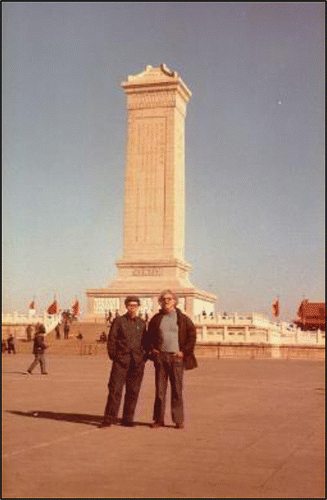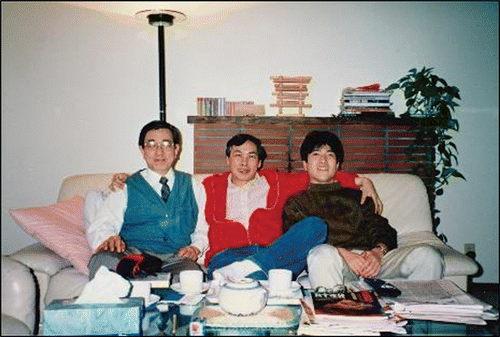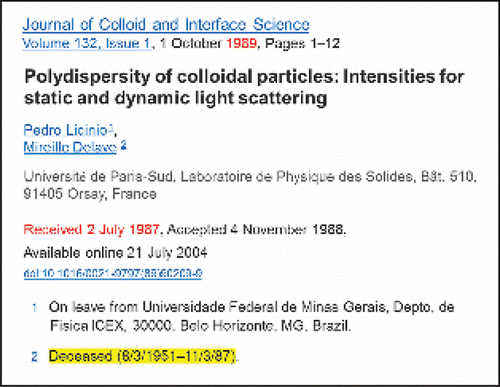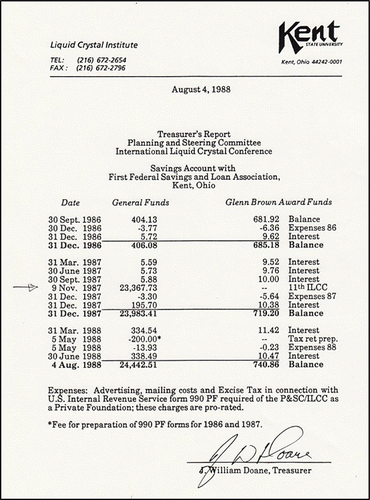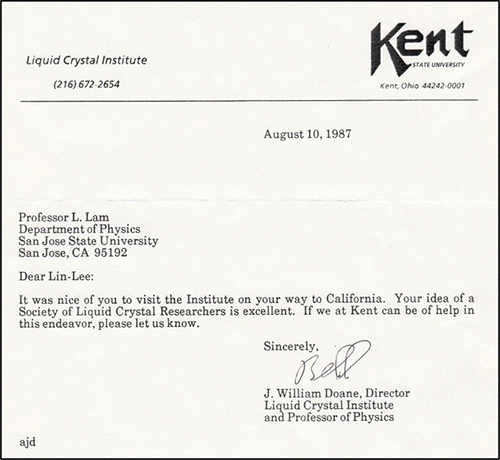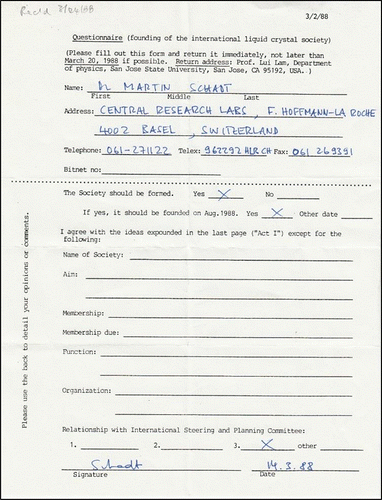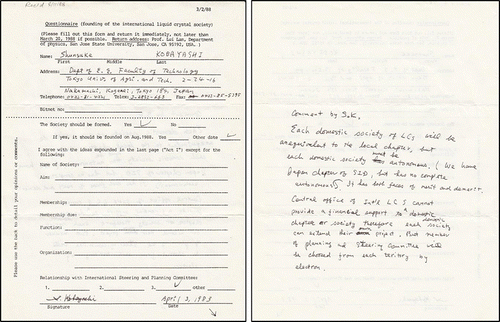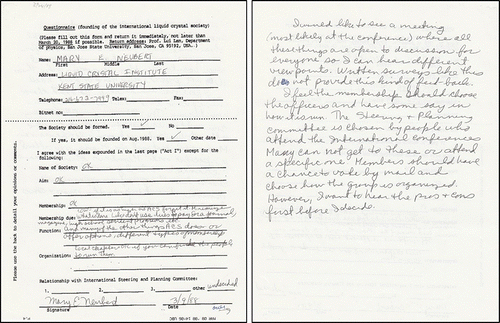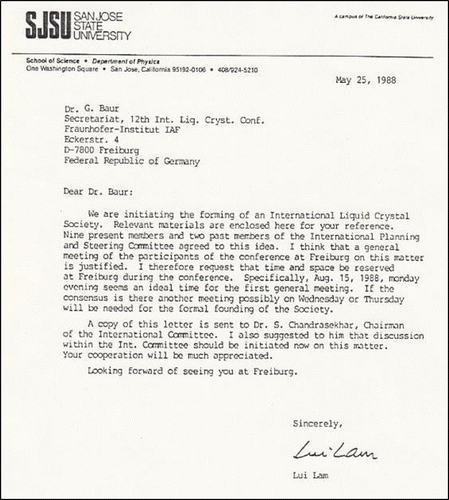ABSTRACT
A personal account of the liquid crystal community (1978–1990s) and the founding of the International Liquid Crystal Society (1987–1990) is presented. The founding process was unlike that of many other learned societies but like other historic events, it resulted from a combination of necessity and contingency.
1. Introduction
I was the one who initiated and orchestrated the founding of the International Liquid Crystal Society (ILCS) Citation[1]. The ILCS replaced The Planning and Steering Committee for International Liquid Crystal Conferences (PSC for ILCC) in 1990. To understand how and why this happened we have to go back to the beginning of the PSC.
The year was 1965. Glenn Brown (1915–1995) established the Liquid Crystal Institute (LCI) at Kent State University, Kent, Ohio, housed in its own building, and organized the first ILCC at Kent (). It was the same year that I graduated from the University of Hong Kong and flew over the Pacific Ocean to start my grad student training at the University of British Columbia (UBC), Vancouver, Canada—my first flight and first trip ever out of Hong Kong, age 20 ().
Figure 1. Left: Glenn Brown. Middle: The Liquid Crystal Institute at Kent (1965). Right: Program cover of the first ILCC (1965).
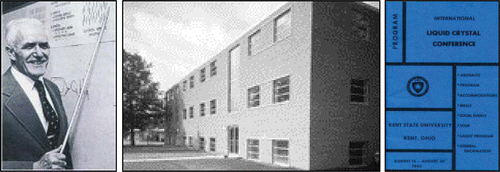
Figure 2. Lam outside of residence in Vancouver, near the UBC campus—first photo outside of Hong Kong and first snow in life (1965).
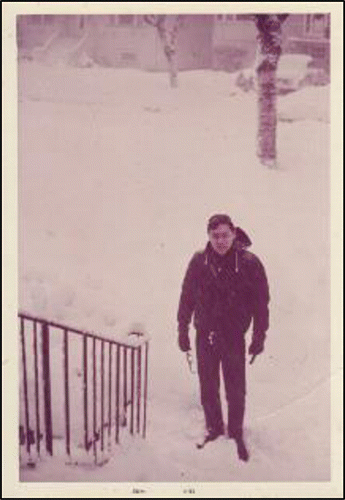
In the 1st ILCC in 1965, there were two organizing committees: the Planning Committee and the Steering Committee. The full name Planning and Steering Committee first appeared in the 2nd ILCC in 1968, also at Kent. Note that Brown was the chair of both; he was the founder of the ILCC series (). According to Bill Doane, who started working at Kent in 1965: “In the beginning, there were few researchers on liquid crystal materials and the PSC was open to anyone whom they could count on to do the work required for establishing and growing this organization… George Gray and Chandra worked closely with Glenn Brown in its founding and growth” Citation[2].
Figure 3. The organizing committees of the 1st and 2nd ILCC Citation[2].
![Figure 3. The organizing committees of the 1st and 2nd ILCC Citation[2].](/cms/asset/fd85ccfe-f50d-43c3-9301-9814e7fc6a8b/gmcl_a_1289627_f0003_oc.gif)
ThePSC expanded somewhat over the yearsFootnote1 and had made important contributions in establishing LC as a research field and a profession Citation[3]. A dividing point in its history was 1980 while Brown, who started having Parkinson disease in the 1970s Citation[2, 4], stepped down as chair of PSC. He was succeeded by George Gray (1926–2013) who, four years later, passed the chairmanship to Sivaramakrishna (Chandra) Chandrasekhar (1930–2004) who had a PhD from the United Kingdom. Gray remained in the PSC though. From what I could gather as a PSC member in the1980s, apparently, Gray and Chandra shared a vision of the PSC's future differing from Brown's. Note that throughout the PSC's existence (1965–1990), its only function was to select a site for the next ILCC every two years. Also, the PSC was a somewhat closed organization: no membership applications.
The major events related to the founding of the ILCS are summarized in , which will be elaborated in subsequent sections.
Table 1. Timeline of important events in liquid crystal developments and the life trajectory of Lui Lam, 1965-1990.
2. The liquid crystal community, 1978–1990s
Over the years, especially after the twisted nematic display was invented in 1970, size of the LC community has expanded steadily (). While the PSC's structure and function remained still, discontent from both developing and developed countries bubbled up. The LC professionals in many countries felt that they were not getting their fair share of attention from their respective scientific community, and jobs for new PhDs in LC declined very fast in number.
Figure 4. Number of papers presented at the first 13 ILCCs, 1965–1990. (Data source: Program book of the 13th ILCC, Vancouver, 1990.)
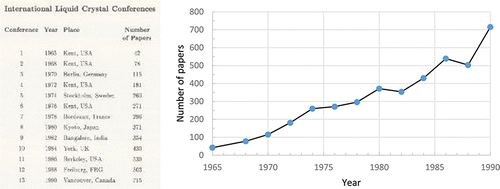
My involvement in LC research started in 1972, my first postdoc year at City College, City University of New York. Apart from the 1973 Les Houches Summer School on molecular fluids where I attended the lectures by Pierre-Gilles de Gennes (1932–2007) and Bob Meyer and got to know Roland Ribotta from Orsay, I did not have contact with the LC community until I went back to join the revolution in China, in January 1978 Citation[5, 6].
I was assigned to do research at the Institute of Physics, Chinese Academy of Sciences (CAS), Beijing (). The institute was the top research place in China; five colleagues of mine went on to become CAS' academicians (). As circumstances dictated, I chose to do LCs and was the only government-certified PhD mentor in LC physics. At that time, the LC community in China was rather small Citation[7]. The LC group at Tsinghua University was nearby and I collaborated with some of them (). Incidentally, my 1979 paper on nematic-isotropic phase transitions Citation[8] is the first Physical Review Letters paper by mainland-only Chinese authors (which in fact is my 2nd English, and overall 3rd, paper on LC).
Figure 6. Lam and his two colleagues from the Institute of Physics in Lushan (Aug. 1978), who became academicians of the Chinese Academy of Sciences. Yu Lu went on to win The American Institute of Physics (AIP) 2007 Tate Medal for Leadership in International Physics.
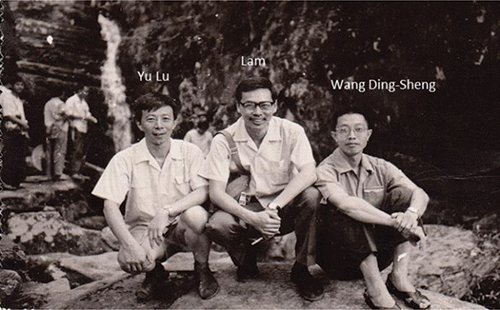
Figure 7. Lam with Tsinghua's LC group, on the occasion of Ou-Yang Zhong-Can's PhD thesis defense (July 2, 1984). Xie Yu-Zhang (1915–2011) was the thesis advisor. Xie, together with Zhao Jian-An and Ruan Liang, and I founded the Chinese Liquid Crystal Society in summer 1980.
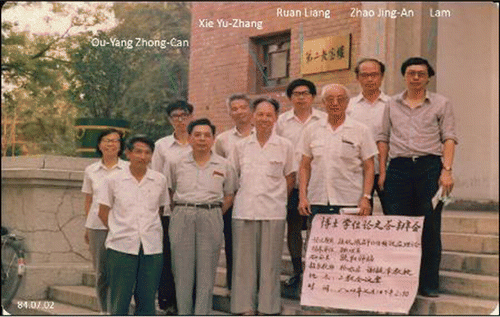
The year 1980 was crucial for the Chinese LC community. I led a delegation to the 8th ILCC in Kyoto, Japan, June 30-July 4 ()—the first one ever in this series attended by mainland Chinese LC scientists. After Kyoto, Chandra and Sven Largerwall visited Beijing and attended the founding ceremony of the Chinese Liquid Crystal Society (CLCS, see caption)—the first national one in the world.
Figure 8. Program covers of three ILCCs: the 8th (Kyoto, 1980), 12th (Freiburg, 1988) and 13th (Vancouver, 1990). Note that the spelling of my family name switched back from Lin to Lam over the years. Lin and Lam correspond to the same Chinese character; Lin is in pinyin, Lam in Cantonese.
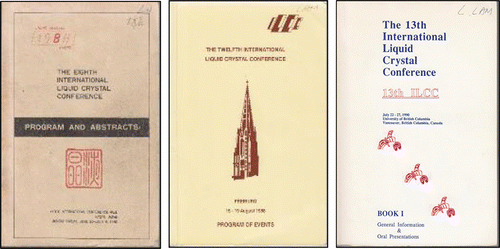
In a congratulatory letter (dated Sept. 4, 1980) on CLCS's formation from Kent's Adrian de Vries, a PSC member then, he expressed the wish that “Maybe more countries will follow now, and maybe the International Planning and Steering Committee will then also reorganize itself in a more formal way.” It did happen that way: the British Liquid Crystal Society was formed in 1985 Citation[9], and the PSC transformed itself, albeit reluctantly, into the ILCS in 1990. However, de Vries' letter was not in my mind when I initiated the ILCS in 1987, which was prompted by something else (see below).
In September 1980, Orsay's “Gang of Four” toured China (). And in 1982, I predicted the existence of bowlics Citation[10, 11]—the 3rd type of LCs () while working on propagating solitons in nematics Citation[5, 12].
Figure 9. Orsay's “Gang of Four” (Jean Charvolin, Georges Durand, Maurice Kléman and Roland Ribotta) with their local hosts at Wuhan Provincial Museum, Wuhan (Sept. 1980).
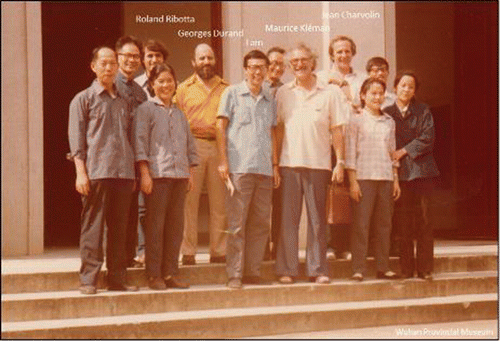
Figure 11. Three types of liquid crystals: rodics, discotics and bowlics, corresponding to one-, two- and three-dimensional molecules, respectively. Of course a physical LC molecule is three dimensional; the dimensionality here refers to the molecule's dimension used in modeling. Bowlic monomers and polymers were synthesized, and the term bowlic/bowlic liquid crystal is recognized officially by the IUPAC and formally in Handbook of Liquid Crystals. Ferroelectric columnars studied in recent years are bowlic columnars. (For an early review, see Citation[13].)
![Figure 11. Three types of liquid crystals: rodics, discotics and bowlics, corresponding to one-, two- and three-dimensional molecules, respectively. Of course a physical LC molecule is three dimensional; the dimensionality here refers to the molecule's dimension used in modeling. Bowlic monomers and polymers were synthesized, and the term bowlic/bowlic liquid crystal is recognized officially by the IUPAC and formally in Handbook of Liquid Crystals. Ferroelectric columnars studied in recent years are bowlic columnars. (For an early review, see Citation[13].)](/cms/asset/2018f661-6c9f-466c-b27f-8b8de34f4852/gmcl_a_1289627_f0011_oc.gif)
The LC community in the 1980s was not large, just about a few hundred people (). Through mutual visits and attending conferences like the ILCCs we kind of know each other and many of us became friends with each other ().
Figure 12. Lam in Kléman's home, Paris (Jan. 1983). Kléman's wife (right) joined the 1980 China tour.
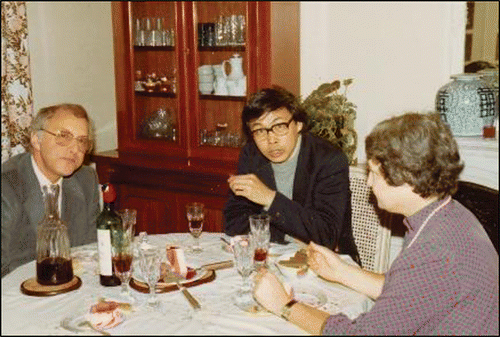
Figure 14. Some liquid crystalists attending the “3rd Asia Pacific Physics Conference” at the Chinese University of Hong Kong (June, 1988). Lam presented a paper on possible liquid crystalline high Tc superconductors Citation[14], predicted first in Citation[11].
![Figure 14. Some liquid crystalists attending the “3rd Asia Pacific Physics Conference” at the Chinese University of Hong Kong (June, 1988). Lam presented a paper on possible liquid crystalline high Tc superconductors Citation[14], predicted first in Citation[11].](/cms/asset/7fffcafe-a900-47f6-9102-7e6372a2f862/gmcl_a_1289627_f0014_oc.gif)
Figure 15. Lam in Shu-Hsia Chen's lab, Hsinchu, Taiwan (July 1991). Left to right: Yuh-Ren Shen, Wei-Jou Chen, Lam, Ban-Jy Liang, Shu-Hsia Chen, Jong-Guang Wei and Chin-Yih Chen. All five students went on to earn PhDs.
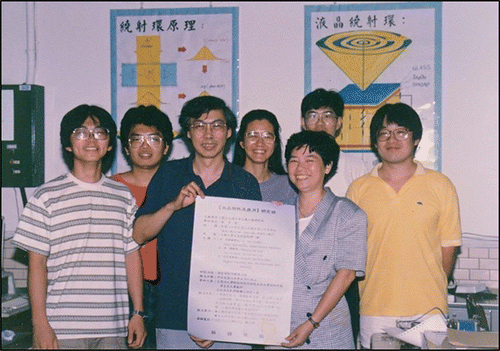
Figure 17. Some liquid crystalists on their way to Los Alamos for a visit while participating in a workshop in Santa Fe, New Mexico (April 1993). The NATO Advanced Research Workshop “Spatio-temporal Patterns in Nonequilibrium Complex Systems” was organized by Patricia Cladis and Peter Palffy-Muhoray. Mitsugu Matsushita didn't work in LCs but was well known for his first experiments showing the diffusion-limited aggregation pattern and bacteria pattern formation. This conference, not limited to LCs, gathered the world's top players in pattern formation under one roof.
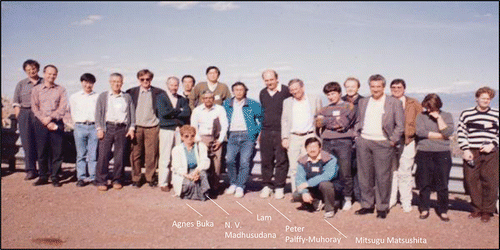
3. Women in liquid crystals
Woman scientists are among the people whom I admire and have empathy with since they have to overcome more obstacles compared to men for professional achievements Citation[15]. And they are underrepresented in science, especially in physics. Because of the interdisciplinary nature of LC research that involves chemistry, biology and physics, it would not be surprising to find quite a number of woman scientists in the field. What was unusual, for me at least, was the significant number of prominent woman physicists in LCs. Those I knew personally include Agnes Buka (Hungary), Patricia Cladis (USA), Flonnie Dowell (USA), Elisabeth Dubois-Violette (France), Anne Levelut (France), Ru-Pin Pan (Taiwan) and Xiao-Wei Zhuang (USA).Footnote2
Mireille Delaye (1951–1987) did not belong to this list of acquaintances. I met her only once. It happened during one of my Orsay visits. Her lab door was open. I invited myself in and chatted with her for a few minutes on the experiment she was doing. She was young, elegant and obviously bright.Footnote3 Few years later, in July 1987, on my way to the LC polymer conference in Bordeaux, I stopped at Orsay again. I asked Georges Durand about Mireille and was told that she had passed away. [Only years later that I learned that she committed suicide, age 36, just four months before my visit ().] After shock, came sadness and disappointment. How come I didn't know about it before, I asked myself? My answer was that the LC community lacked a publication like the Physics Today in which, in every issue, there is the section of obituaries. And to have a Liquid Crystals Today for the LC community, we first needed a society that would publish it. That is, we needed an international LC society. Besides, an international society that we liquid crystalists could call it our own was overdue Citation[1].
4. Founding the international liquid crystal society, 1987–1990
Organizingan international society, for me, would not be that difficult. I had organized many things before: mass organization (Chinatown Food Co-op Citation[19]), street demonstrations (Baodiao Movement Citation[20]), national society (CLCS), book series (Partially Ordered Systems), and research groups (in Beijing and San Jose). Furthermore, having worked in Europe, USA and China, being admitted to the PSC in 1984,Footnote4 and having attended enough number of LC conferences worldwide enabled me to know almost everyone in the field, East or West.
To proceed in 1987, theoretically, there were two possible approaches: top-down or bottom-up. The top-down approach would be straightforward and easy. As a PSC member, I could go to the chair of the PSC and convince him that an ILCS was a good idea and timely. This would work if Glenn Brown was still the PSC chair because he would simply say yes (see ) and that would be it and we would have the ILCS installed at the 12th ILCC in Freiburg in 1988, the centenary year of the discovery of LC. Unfortunately, at this point, Brown was no longer the chair (see Section 1).
The bottom-up approach would be exciting but drastic, like an uprising. To guarantee success, I decided to procced with a mixed approach: first bottom-up, then top-down. Specifically, I would (1) drum up enough support from the LC community, (2) hold an open meeting at Freiburg to allow input from the masses, and then (3) ask the PSC to transform itself into an ILCS. The first step went smoothly, then something unexpected happened (see below).
From July 1987 to Feb. 1988, I visited six places across Europe and North America to spread the word and enlist support for an ILCS (). My second stop was Kent where I met Glenn Brown for the first time, and Bill Doane and Alfred Saupe (1925–2008) and others. Their responses were very positive (see ). And I collected a few memorabilia (). Note that the LC thermographic cards had been used at the 11th ILCC at Berkeley the previous year (). In fact, at end of 1987, I was so optimistic that in a letter (dated Dec. 29, 1987) on something else to Horst Stegemeyer, Chair of 12th ILCC's Scientific Committee, I said: “At this point, it seems very likely that we should be able to found the Society at Freiburg next year. I think that the Conference Committee should be alerted about this possibility at an early time.”
Figure 20. Places in Europe and North America I visited from July 1987 to Feb. 1988, to make connections and enlist support for an ILCS. 1. Bordeaux (July '87). 2. Kent (Aug. '87). 3. Boulder (Aug. '87). 4. Budapest (Aug. '87). 5. Pardubice (Aug/Sept. '87). 6. Vancouver (Feb. '88).

Figure 22. Lam's LC thermographic name card received at the 11th ILCC, Berkeley, June 30-July 4, 1986.

On March 2, 1988, I contacted a selected group of LC people, including all current PSC members, by mail. Each mail contains four documents: (1) a cover letter explaining why an ILCS should be formed and urging the recipient to copy and distribute the documents to their colleagues, (2) a page called Act I laying down my vision of the ILCS (), (3) a copy of Doane's supporting letter (), and (4) a questionnaire asking the recipient for comments on the ideas expounded in Act I with optional remarks added to the back of page ().
Figure 23. Act I (Mar. 2, 1988), detailing Lam's vision of the ILCS. Among other things, it recommends that the ILCS should publish a magazine (modeled after Physics Today), points out that forming the ILCS from the PSC by expanding it would be most practical (even though, tactically, two other options are also listed), and proposes to form the ILCS at Freiburg in Aug. 1988.
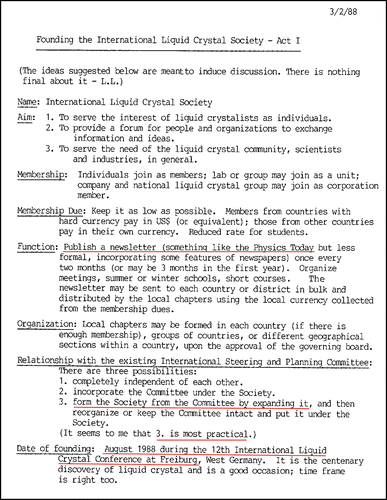
Figure 25. Questionnaire filled out by Glenn Brown (Mar. 22, 1988). He couldn't do hand writing himself (due to Parkinson disease) and so he asked someone else do it for him but initiated it himself near his signature on each page.
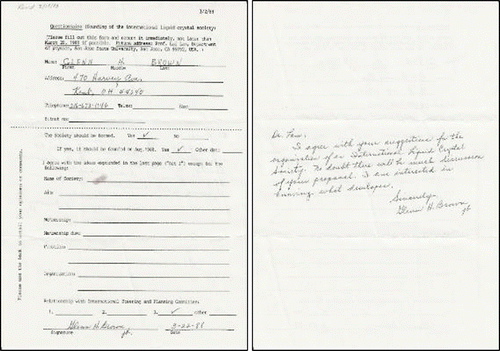
By May 25, 1988, I had received 61 responses from 14 countries, including those from 11 (9 current and 2 past) PSC members. Samples are provided in . Some responses were brief () while others came with thoughtful comments elaborated (). All agreed to form the ILCS; almost all wanted it to be formed at the 12th ILCC (see for an exception); all wanted it to be formed from the PSC by expanding it (), with one exception (). The exception was from Mary Neubert who was undecided on this issue. Her added remark (like coming from a New Yorker) stood out and was close to my heart. In full, she wrote:Footnote5
I would like to see a meeting (most likely at the conference) where all these things are open to discussion for everyone so I can hear different viewpoints. Written surveys like this do not provide this kind of feed-back. I feel the membership should choose the officers and have some say in how it is run. The Steering and Planning Committee is chosen by people who attend the International Conferences. Many can not get to these or attend a specific one. Members should have a chance to vote by mail and choose how the group is organized. However, I want to hear the pros & cons first before I decide.
Figure 27. Questionnaire filled out by Bill Doane (Mar. 8, 1988). This was one of many from Kent collected by Elaine Landry, Assistant to Doane the Director, and sent to me in a package.
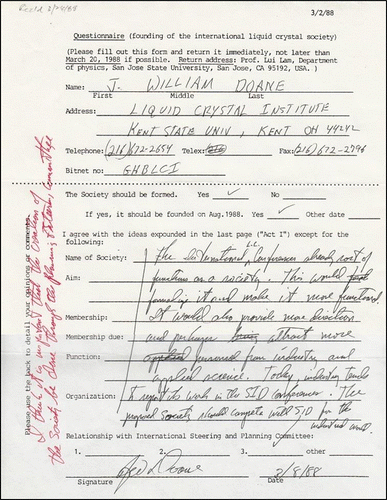
There was one problem though. Among the respondents, the notable absentees were George Gray and Chandra—the immediate ex- and current Chairs of the PSC. To get it going, I summed up the 61 responses on one page called Act II (dated May 25, 1988) in which I wrote that “A brief statement as an open letter to the participants of the Freiburg Conf. is prepared here and will be distributed to all during the registration period (assuming the consent of the organizers, of course)” Citation[1]. The statement ended with the 61 respondents' names (see for the final version). Respondents were allowed to withdraw their names from this open letter but none of them did. Act II was sent to all who sent back their questionnaires. On the same day, I sent a letter to Chandra (), with copy to all PSC members, and a letter to G. Baur, the Secretariat of the 12th ILCC (). Specifically, I suggested to Chandra that, in view of the strong grassroots support, the PSC “should start discussing the proposal and its position in regard to the forming of the International LC Society.” I also proposed that the PSC should have a meeting on the Sunday before the Freiburg conference started. To Baur, I wrote: “I think that a general meeting of the participants of the conference at Freiburg on this matter is justified. I therefore request that time and space be reserved at Freiburg during the conference.” I got no reply from Chandra nor Baur. I, together with the 61 respondents, were ignored.
Figure 30. Letter from Lam to Chandra (May 25, 1988). In the 2nd paragraph, “13th” was a typo, which should be replaced by “12th”.
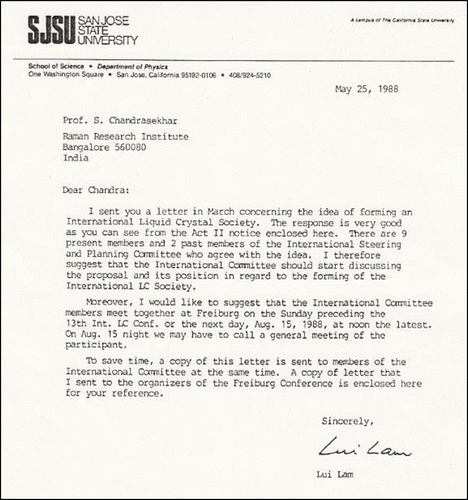
The 12th ILCC was scheduled for August 15–19, 1988 (). A letter (dated July 14, 1988) from Chandra to PSC members finally arrived. It contained the tentative agenda for PSC's next meeting in Freiburg, which consisted of five items. In Item 4—Election of new Members to replace retiring members, it was written that “S. Chandrasekhar, elected as Chairman in 1984 for a period of 4 years” was scheduled to “retire at the end of the Freiburg Conference.” In Item 5—Founding of an International Liquid Crystal Society - proposal received from Prof. Lui Lam, Chandra noted that “It appears that many scientists are in favour of this idea. This is an important question that needs to be discussed in detail…Members of the IPSC are requested to give this matter serious thought and express their views during the meeting.”
The moment of truth was approaching. On Tuesday, August 16, 1988, at 3 pm in the Conference Building, Room 2114 c, the PSC had its business meeting (which, by tradition, only met every two years at an ILCC). Once the meeting was opened by Chandra, Gray said, “Let Chandra continue to be the next Chair.” And that was it. Chandra now became our “new” Chair for the next two years. Soon, I presented the Petition signed by 82 people () and proposed that we transformed the PSC into an ILCS. Gray asked immediately, “What will happen to the PSC members?” My answer: “They will be the Board members of the new ILCS.” And so, the proposal was passed unanimously without further discussion. Suddenly, it dawned on me that Gray and Chandra were not against an ILCS per se; it depended on who would head it. Obviously, unlike Neubert and me, they didn't like mass meetings.
Figure 32. The Petition: Flyer distributed before Aug. 16, 1988, the date of the PSC meeting, at the 12th ILCC, Freiburg Citation[1]. There are 82 signees (1 from UK and 0 from India).
![Figure 32. The Petition: Flyer distributed before Aug. 16, 1988, the date of the PSC meeting, at the 12th ILCC, Freiburg Citation[1]. There are 82 signees (1 from UK and 0 from India).](/cms/asset/03dd77f6-d612-473b-8145-54353338dd18/gmcl_a_1289627_f0032_b.gif)
A subcommittee of five people charged with formulating the transformation was formed. The decision was announced by Chandra to the conference participants the next day. On August 18, I was asked to draft the bylaws because no one else in the subcommittee wanted to do it. The bylaws was finished 11 months later, on July 15, 1989. (See Acts III and IV in Citation[1]). Everything I proposed in Act I were included in it, including an official magazine called Liquid Crystals Today. In particular, it was stipulated that in the first two years of the Society, the Board of Directors—the governing body—should consist of the existing members of the PSC (as I promised Gray) and other individuals appointed by the PSC. It was not a mass organization at this point. But at least, people could apply for membership once it was formed and run for president two years later. There were other stipulations, of course Citation[1].
The 13th ILCC, chaired by Peter Palffy-Muhoray, was held at UBC, Vancouver, July 22–27, 1990 (). I found myself back to my Alma Mata, age 45. In campus, Chandra let me know he wanted to be the president; I didn't object. Chandra and I then invited Martin Schadt to be the vice president Citation[1]. And with the bylaws approved, the PSC dissolved itself and the ILCS was established. I assumed the Chair of the Conference Committee, which took over the job of the PSC—picking an ILCC site every two years. The new ILCS was announced on Friday, July 27 at the closing ceremony and people were invited to join (). Thus, officially, the ILCS was born on July 27, 1990, in Vancouver.Footnote6 It began with 22 Members—the 20 PSC members (listed in ) plus two new officers (Schadt the Vice President and David Dunmur the Secretary)—who, incidentally, were also members of the Board of Directors.
Figure 33. ILCS' first official document, announcing its own existence and inviting the LC community to join in as members Citation[1]. It was prepared by Lam in San Jose before the 13th ILCC, Vancouver, 1990, and was distributed at the conference. That is why there was no date in this document. Note that two persons from Kent, Brown and Doane, were among the founding board directors.
![Figure 33. ILCS' first official document, announcing its own existence and inviting the LC community to join in as members Citation[1]. It was prepared by Lam in San Jose before the 13th ILCC, Vancouver, 1990, and was distributed at the conference. That is why there was no date in this document. Note that two persons from Kent, Brown and Doane, were among the founding board directors.](/cms/asset/7214106c-2e9f-4458-ba7e-5ac34265b965/gmcl_a_1289627_f0033_oc.gif)
Finally, the job was done. We got everything we wanted, except a mass meeting and the wish to found the ILCS in 1988, disappointing Friedrich Reinitzer perhaps. I was exhausted. And I missed Glenn Brown.
5. Conclusion
What presented here is a personal account of a small slice of the prehistory of the ILCS, restrictive in both time and space. A more complete picture will emerge when enough number of others come forward and write down what they know from their own perspectives. I hope this will happen in the future.
The ILCS may be inevitable. But contingency was at play in its particular way of coming into being, like in other historical events Citation[22]. The timing was prompted by the abrupt departure of a French woman scientist. The ILCS is a French-inspired, Chinese-initiated, truly international mass organization. Kent people had made important contributions in helping it happen.
Acknowledgments
Glenn Brown and his institute kept inspiring me in my LC years and beyond. I am grateful to Bill Doane for information and discussion concerning Kent's LCI and the ILCCs and a private tour of the campus, to Peter Palffy-Muhoray and Hiroshi Yokoyama for arranging my talk at the 26th ILCC, Kent, 2016, and to the latter for waiving my registration fee which made my participation possible. I would like to take this occasion to thank openly my 81 fellow signees of the historic 1988 Petition which helped crucially in ushering in the ILCS.
Notes
1 See Table 10.1 in Citation[1] for a full list of PSC members from 1980 to 1990.
2 Among this list, Pan is the only one whom I have published jointly with Citation[16, 17]. Zhuang, while a grad student with Yuen-Ron Shen at Berkeley, gave a talk on LC optics at the 15th ILCC, Budapest, 1994. She won the MacArthur Fellowship in 2003 and is a professor at Harvard University.
3 Delaye was internationally known for her work published in Nature showing that short-range order of crystalline proteins accounts for eye lens transparency Citation[18].
4 I was informed by George Gray by a letter (dated Dec. 11, 1984) that I, together with D. Demus, J. Prost, W. H. de Jeu, A. M. Figueiredo and H. Stegemeyer, were “duly elected” to the PSC. Enclosed was the outcome of the ballot which showed that J. W. Doane was nominated but lost out in this round. At this point, Prost and I were the two youngest PSC members. Two years later, according to a letter (dated Nov. 12, 1986) from Chandra to the PSC members, Bill Doane (with the highest number of 17 votes), A. Fukuda, K. Okano and N. A. Clark were elected to the PSC, and Doane replaced de Vries as the Treasurer who had resigned. The treasurer oversaw the huge profit made by the 11th ILCC, Berkeley, 1986, chaired by David Litster, which became the seed money of the ILCS in 1990 ().
5 Neubert was wrong on one account: The PSC, except perhaps for the first round or so, was not chosen by people who attended conferences. In fact, from my personal knowledge since 1980, it was chosen by people who were already in the PSC.
6 An international organization like ILCS does not need to register with any government and need not be recognized by any government. The nonprofit organization International Liquid Crystal Society, a 501 (c) (6) Business League registered in Ohio State, USA, with address at Kent's LCI and exemption status starting Aug. 1989, is a legal device to handle tax matters (by avoiding it) Citation[2, 21]. The nonprofit organization ILCS and the ILCS founded in Vancouver are two very different things; the officers are different, for example. The former exists to support the latter.
References
- Lam, L. (2014). In: All About Science: Philosophy, History, Sociology & Communication, Burguete, M., & Lam, L. (eds.), Chapter 10, World Scientific: Singapore, 209.
- William (Bill) Doane (2016). Private communication.
- Dunmur, D., & Sluckin, T. (2011). Soap, Science, and Flat-Screen TVs, Oxford U. P.: Oxford.
- Neubert, M. E. (1995). Liquid Crystals Today, 5(2), 1.
- Lam, L. (2014). In: All About Science: Philosophy, History, Sociology & Communication, Burguete, M., & Lam, L. (eds.), Chapter 12, World Scientific: Singapore, 253.
- Lam, L. (2015). Science, 348 (6239), 1170.
- Lin, L. (Lam, L.) (1983). Mol. Cryst. Liq. Cryst., 91, 77.
- Lin, L. (1979). Phys. Rev. Lett., 43, 1604.
- Dunmur, D., & Kitzerow, H. (2016). Liquid Crystals Today, 25(2), 24.
- Lin, L. (1982). Wuli (Physics), 11, 171.
- Lam, L. (1988). Mol. Cryst. Liq. Cryst., 155, 531.
- Lin, L. et al. (1982). Phys. Rev. Lett., 49, 1335; 52, 2190(E).
- Lam, L. (1994). In: Liquid Crystalline and Mesomorphic Polymers, Shibaev, V. P., & Lam, L. (eds.), Chapter 10, Springer: New York, 324.
- Lam, L. (1988). In: 3rd Asia Pacific Physics Conference, Chan, Y. W. et al. (eds.), World Scientific: Singapore.
- Godfroy, A.-S. (2016). In: Humanities as Science Matters, Burguete, M., & Riesch, H. (eds.), Chapter 8, Pantaneto Press: Luton, UK, 149.
- Pan, R.-P., & Lam, L. (1997). In: Centenary Celebration of National Chiao Tung University: Workshop Proceedings, Der-San Chuu (ed.), Chapter 7, NCTU College of Science: Hsinchu, Taiwan, 95.
- Pan, R.-P., Sheu, C.-R., & Lam, L. (1995). Chaos Solitons Fractals 6, 495.
- Delaye, M. (1983). Nature, 302, 415.
- Kuo, C.-L. (1977). Social and Political Change in New York's Chinatown, Praeger: New York.
- The Seventies Monthly (ed.) (1971). Truth Behind the Diaoyutai Incident, The Seventies Monthly: Hong Kong. (See also: http://archives.lib.nthu.edu.tw/exhibition/diaoyun/intro.htm.)
- http://www.taxexemptworld.com/search.asp?type=on&criteria=international+liquid+crystal+society# (Dec. 19, 2016).
- Lam, L. (2008). In: Science Matters: Humanities as Complex Systems, Chapter 13, Burguete, M., & Lam, L. (eds.), World Scientific: Singapore, 234.


